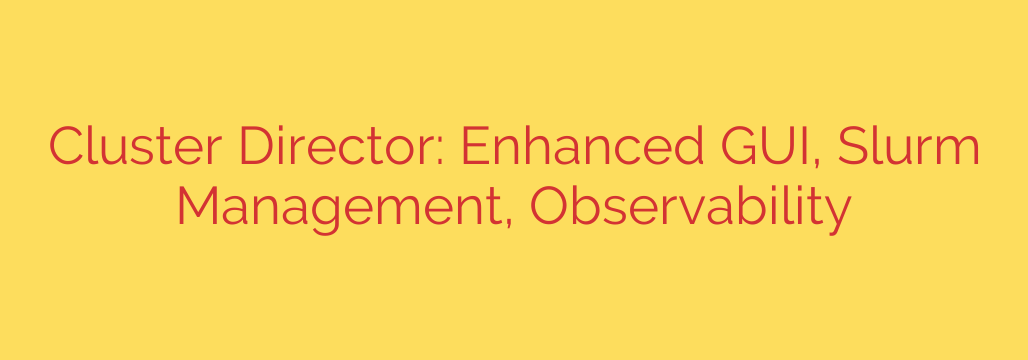
Mastering Your HPC Environment: A Guide to Modern Cluster Management and Observability
High-Performance Computing (HPC) is the engine behind groundbreaking research and complex industrial problem-solving. Yet, managing these powerful clusters has traditionally been a daunting task, often requiring deep command-line expertise and a fragmented set of tools. The complexity of configuring nodes, managing job schedulers, and monitoring system health can create significant overhead, diverting valuable time from innovation.
Fortunately, the landscape of HPC administration is evolving. Modern cluster management platforms are emerging to simplify these challenges, offering unified control, powerful automation, and deep system insight through intuitive interfaces. This shift is making HPC more accessible, efficient, and reliable than ever before.
The Power of an Intuitive Graphical Interface (GUI)
For years, the command line has been the primary way to interact with HPC clusters. While powerful, it presents a steep learning curve and can make visualizing the overall state of a large-scale system difficult. A well-designed graphical user interface changes the game completely.
Instead of typing complex commands to check node status or resource allocation, administrators can now see everything at a glance. Modern GUIs provide a centralized dashboard that visualizes the entire cluster, including compute nodes, storage, and networking components. This visual approach dramatically lowers the barrier to entry for new administrators and empowers seasoned experts to diagnose issues more quickly. Key tasks like provisioning new nodes or updating software can be streamlined into a few clicks, reducing the chance of human error.
Simplifying Slurm Workload Management
Slurm (Simple Linux Utility for Resource Management) is the de-facto standard for workload scheduling in the HPC world. It’s a robust and highly scalable tool, but managing its configuration files and monitoring job queues can be intricate.
Advanced cluster management solutions now offer dedicated features for Slurm, abstracting away much of the underlying complexity. These tools provide centralized control over Slurm configurations across all nodes, ensuring consistency and making updates seamless. Administrators can:
- Visually monitor job queues, seeing which tasks are running, pending, or have failed.
- Analyze resource utilization to understand how efficiently jobs are using allocated CPUs and GPUs.
- Automate the deployment and configuration of Slurm itself, saving hours of manual setup.
This integration transforms Slurm management from a reactive, command-based process into a proactive, visually-driven strategy. It allows teams to optimize job throughput and ensure fair resource allocation with far less effort.
Beyond Monitoring: Achieving True Cluster Observability
Basic monitoring tells you if a system is up or down. True observability, however, tells you why. This is a critical distinction in complex HPC environments where performance bottlenecks or subtle hardware issues can be difficult to trace.
Modern observability goes beyond simple CPU and memory graphs. It integrates three key pillars of data:
- Metrics: Real-time numerical data about system performance (e.g., CPU load, network traffic, GPU temperature, energy consumption).
- Logs: Detailed, time-stamped records of events from applications and the operating system.
- Traces: A complete view of a request or job as it moves through the various components of the cluster.
By unifying these data streams, administrators gain a holistic, real-time view of their entire cluster’s health and performance. This allows them to move from reactive firefighting to proactive optimization. With comprehensive observability, you can pinpoint the root cause of a failed job, identify underutilized hardware, and secure the cluster by detecting anomalous activity.
Actionable Security and Management Tips
As you adopt more advanced management tools, keeping security and best practices in mind is crucial.
- Implement Role-Based Access Control (RBAC): Ensure that users and administrators only have access to the controls and data they need. A good management GUI should allow you to define granular permissions, limiting who can alter configurations or provision new resources.
- Establish Alerting Baselines: Don’t wait for a system to fail. Use the observability data to establish normal performance baselines. Set up intelligent alerts that notify you when metrics deviate from this norm, allowing you to proactively identify and resolve issues before they impact users.
- Regularly Audit Configurations: Use your centralized management platform to regularly review and audit system configurations. This helps ensure that security policies are consistently applied and that no unauthorized changes have been made.
By embracing these modern management principles and tools, organizations can unlock the full potential of their HPC investments, ensuring their systems are not only powerful but also efficient, secure, and easy to manage.
Source: https://cloud.google.com/blog/products/compute/managed-slurm-and-other-cluster-director-enhancements/








